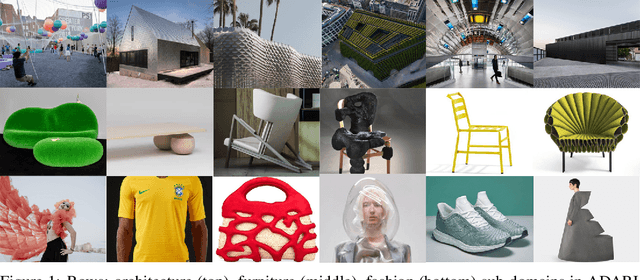Daragh Byrne
Feature space exploration as an alternative for design space exploration beyond the parametric space
Jan 26, 2023Abstract:This paper compares the parametric design space with a feature space generated by the extraction of design features using deep learning (DL) as an alternative way for design space exploration. In this comparison, the parametric design space is constructed by creating a synthetic dataset of 15.000 elements using a parametric algorithm and reducing its dimensions for visualization. The feature space - reduced-dimensionality vector space of embedded data features - is constructed by training a DL model on the same dataset. We analyze and compare the extracted design features by reducing their dimension and visualizing the results. We demonstrate that parametric design space is narrow in how it describes the design solutions because it is based on the combination of individual parameters. In comparison, we observed that the feature design space can intuitively represent design solutions according to complex parameter relationships. Based on our results, we discuss the potential of translating the features learned by DL models to provide a mechanism for intuitive design exploration space and visualization of possible design solutions.
Multimodal Word Sense Disambiguation in Creative Practice
Jul 15, 2020



Abstract:Language is ambiguous; many terms and expressions can convey the same idea. This is especially true in creative practice, where ideas and design intents are highly subjective. We present a dataset, Ambiguous Descriptions of Art Images (ADARI), of contemporary workpieces, which aims to provide a foundational resource for subjective image description and multimodal word disambiguation in the context of creative practice. The dataset contains a total of 240k images labeled with 260k descriptive sentences. It is additionally organized into sub-domains of architecture, art, design, fashion, furniture, product design and technology. In subjective image description, labels are not deterministic: for example, the ambiguous label dynamic might correspond to hundreds of different images. To understand this complexity, we analyze the ambiguity and relevance of text with respect to images using the state-of-the-art pre-trained BERT model for sentence classification. We provide a baseline for multi-label classification tasks and demonstrate the potential of multimodal approaches for understanding ambiguity in design intentions. We hope that ADARI dataset and baselines constitute a first step towards subjective label classification.
 Add to Chrome
Add to Chrome Add to Firefox
Add to Firefox Add to Edge
Add to Edge